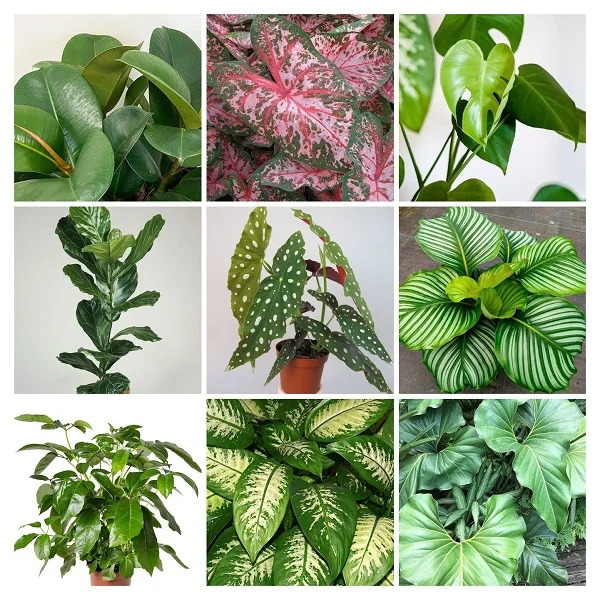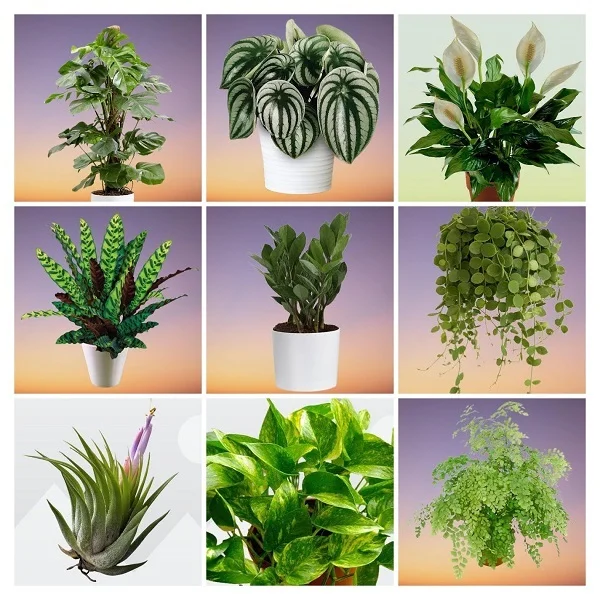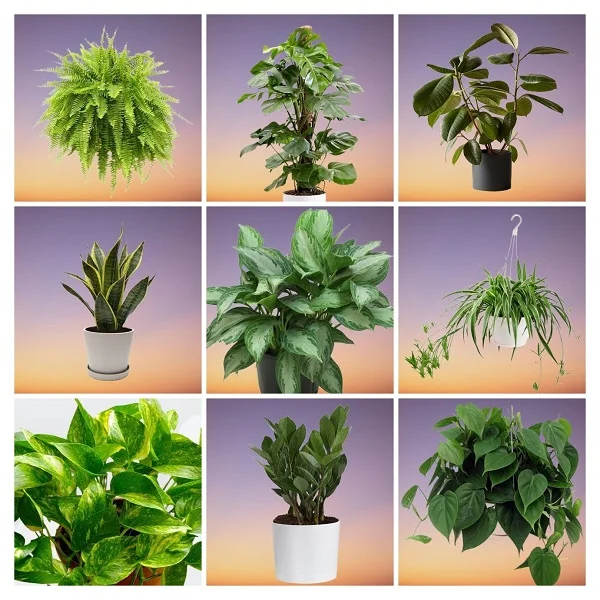Painted Nettle (Coleus blumei) Indoor Care, Propagation, Common Problems and Remedies
Some links in this post may be affiliate links
Painted Nettle (Coleus blumei) thrives in very bright light, average warmth, moderate humidity and consistently moist, fertile, well-drained soil coupled with regular feeding in the growing season.
Coleus is fast-growing and low-maintenance, making it perfect for beginners. In this guide, we will cover how to keep your Coleus happy indoors, including best propagation methods and solutions to common problems. First, let's delve into some facts about this colorful plant.
Coleus blumei or simply Coleus offers a multicolored display of foliage and a bewildering choice of hybrids making beautifully colored plants.
There is no basic color in Coleus; almost every conceivable mixture can be found. There are some attractive single-colored varieties but the usual choice is for the multi-colored varieties.
The leaves come in all manner of colors, forms and shapes. Most but not all have nettle-like leaves. There are also ruffled ones, frilly ones and wavy-edged ones.
Coleus like Caladiums are some of the best foliage plants for the home on account of their brightly colored leaves.
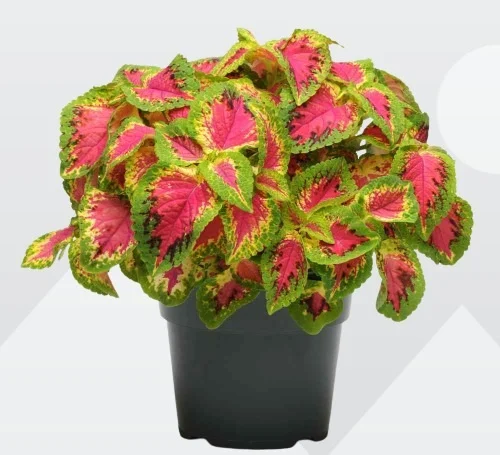
Botanical name: Coleus blumei
Synonyms: Coleus scutellarioides, Plectranthus scutellarioides
Family: Lamiaceae
Common names: Painted Nettle, Coleus
Origin
Coleus blumei also called Coleus scutellarioides or Plectranthus scutellarioides is native to to southeast Asia through to Australia.
Flower
The inflorescence in Painted Nettle is borne on the end of a stem and is very variable in size being up to 1.6 inches long, with few or many flowers. Pinch off the flower spikes as soon as you sight them as they will detract from the beautiful foliage.
Size
Coleus can grow to the height of 2-5 feet and about the same width within a short time. Dwarf varieties are also available. Painted Nettle is one of the fast growing low-light plants.
Toxicity
Painted Nettles (Coleus blumei) are non-toxic to humans but is mildly toxic to pets according to Plantaddicts.com. The plants contain a toxic substance which causes vomiting, diarrhea, depression and loss of appetite in pets if ingested. Keep these plants away from cats, dogs and other pets.
Where to Buy
If you would like to add Coleus to your collection, you may obtain them online from Etsy (Link to Etsy).
How do you care for a Coleus Plant indoors?
To care for a Coleus Plant indoors give it very bright light, average warmth of 15-260C, moderate humidity of 50-55% and consistently moist, fertile, well-drained soil coupled with fortnightly feeding in the growing season.
Painted Nettle care requires regular pruning to keep it neat, to reduce pest infestation, and to control and rejuvenate growth. Keep reading for more on the best growing conditions and how to provide them.
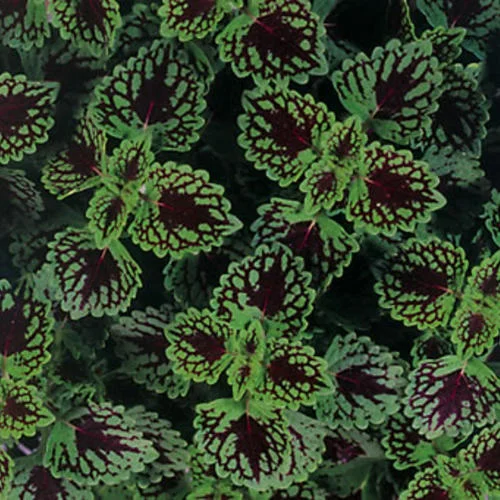
Water Requirements
How often should I water Coleus indoors?
Do not water Coleus on a schedule to avoid overwatering or underwatering.
Water your Coleus liberally in spring and summer and allow the top 1-2 inches of soil to dry out between waterings. Keep the soil consistently moist but not soggy to avoid yellowing of leaves and rotting of stems.
Decrease watering in fall and winter to keep the soil slightly moist as growth is minimal at this time. Do not let the soil dry out completely to prevent crispy leaf edges and wilting, drooping leaves.
Use a pot with a drainage hole and well-draining soil to avoid getting soggy as it can lead in root-rot and death of the plant.
Only use soft water like rain water or filtered to water Coleus to avoid white spots on the leaves.
Avoid wetting the foliage during watering to minimize fungal diseases; apply the water at the base of the plant or water from the bottom.
Light Requirements
Where does Coleus grow best?
Coleus grows best in bright light with 4-6 hours of morning or late afternoon sunlight. Place infront of a large window with some morning sunlight falling on the leaves. Keep it away from hot midday sunshine to avoid scorching of the leaves.
Too little light for Painted Nettle will result in dull colors and leggy growth. If the natural lighting is not adequate, you may use grow lights to supplement it.
Rotate the pot regularly to ensure that the plant receives light on all sides for uniform growth.
Outdoors, Coleus can grow under direct sunlight but it needs to be acclimated gradually by placing it in a brighter spot every few days.
Temperature and Humidity
Coleus prefers average warmth of 15-260C with a minimum 130C. Keep it away from cold drafts as they can cause stunted growth and leaf drop.
Average humidity of 50-55% is ideal for Painted Nettle. Dry air may result in brown leaf tips and edges. To heighten humidity, set the pot on a wet pebble tray, use a humidifier or grow the plant in a well-lit bathroom. Do not mist the leaves as water on the leaves can cause white spots on the leaves.
Fertilizer
What is the best fertilizer for Coleus?
Feed your Coleus with a balanced, water soluble fertilizer every 2 weeks in spring and summer. Avoid too much fertilizer as it can result in leggy growth.
Do not feed in fall and winter as growth is reduced and feeding at this time may lead to fertilizer burn and death of the plant.
Potting Soil
The best soil for Coleus should be a light, well-draining soil that retains moisture without becoming soggy. A blend of 50% potting soil, 30% peat moss or coconut coir (for moisture retention) and 20% perlite or sand (for aeration and drainage) is ideal for this plant.
Repotting
How to repot a Coleus Plant
- Cut back the leggy foliage the beginning of the growing period (spring) to rejuvenate growth and also encourage a compact, bushy growth.
- Select a pot one size larger than the current one. Ensure it has a drainage hole to prevent root-rot. Check out these pots with drainage holes on Amazon.
- Fill the pot halfway with well-draining soil, moisten it slightly and make a hole in the center of the pot.
- Place the plant in the previously made hole and firm the soil around it. Keep it at the same soil level as it was in the previous pot to avoid rotting.
- Wet the soil thoroughly until water drips through the drainage hole.
- Replace the plant to its original spot and carry on with normal care.
Pruning & Maintenance
How do you prune Coleus to make it bushy?
- Regularly remove dead foliage to maintain the plant neat and tidy as well as minimize pests and diseases.
- Pinch off the growing tips to encourage a bushy, compact growth.
- Cut back the leggy stems in spring and repot the plant to rejuvenate growth.
- Pinch off the flower spikes as soon as they appear as they will divert the plant's energy from developing the beautiful foliage.
Coleus Propagation
Painted Nettle (Coleus blumei) is propagated in the growing season (late spring to early summer) from stem cuttings or from seeds.
How to propagate Painted Nettle from stem cuttings
The stem cuttings root easily and there is no need for a rooting hormone.
Best Time to Propagate: Spring or early summer.
Success Rate: Very high, especially with water propagation.
Steps to propagate Coleus from stem cuttings
- Take stem cuttings of about 4-5 inches length from a healthy plant. Ensure each cutting has 2-3 leaf nodes as this is where new growth will emerge from.
- Strip off the lower leaves, leaving only the top few to expose the stem.
- Select a 6 or 8 inches pot and ensure that the pot has a drainage hole to prevent the soil from getting soggy to avoid rotting.
- Fill the pot with well-drained, potting mix and moisten the soil slightly.
- Make a hole in the center of the pot and ensure it is wider that the base of the cutting.
- Insert 2-3 inches of the lower cut end of the cuttings in the hole made above.
- Place the set up in warm brightly-lit place away from direct sunlight to avoid scorching.
- Maintain the soil moist until new growth emerges and substantial growth is observed on the cuttings. Roots develop in 2-4 weeks.
- Once well established, repot the new plants into a pot 1 size larger than the current one in well-draining soil.
- Place the new plants in a warm spot under bright indirect light and begin routine care.
How to propagate Painted Nettle from seeds
Best Time to Propagate: Early spring.
Success Rate: Moderate; requires patience.
Steps to grow Coleus from seeds
- Fill a seed tray with light potting soil.
- Sprinkle the seeds on top of the soil; do not bury, as they need light to germinate.
- Mist the soil lightly and cover with plastic wrap to create a greenhouse effect.
- Place the set up in a warm place (about 210C) away from direct sunlight.
- Maintain the soil moist until the seeds germinate; seeds germinate in 7-14 days.
- Once seedlings have 2-3 true leaves (about 8-10 inches high), transplant into idividual pots in well-drained soil after which you can begin routine care.
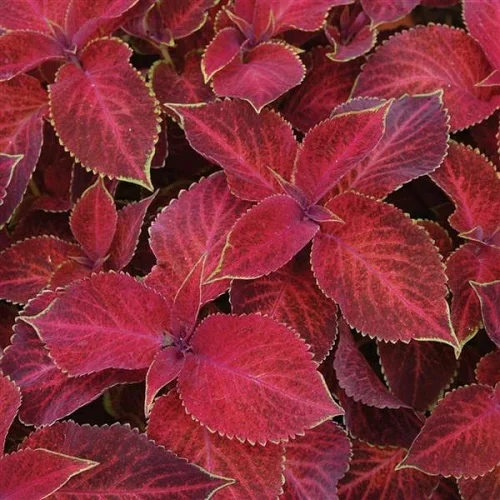
Coleus blumei Common Problems
Painted Nettle (Coleus blumei) common problems are wilting and drooping leaves, plant dying, curling and browning leaves, leggy growth, leaf drop, pests and diseases among others. Keep reading for more on these problems, their remedies and solutions.
Wilting and drooping leaves
What causes Coleus to wilt?
Wilting and drooping leaves on Coleus is caused by underwatering, hot direct sunshine, spider mites infestation, and high temperatures.
How to fix it
Underwatering: Water when the top 1-2 inches dry out. Do not allow the soil to dry out completely.
Hot direct sunshine: Keep the plant away from hot midday sunshine or use a light curtain to filter the sunlight.
Spider mites: Regularly check underneath the leaves for webbing and carry out timely control measures. Keep the plant well-pruned and raise humidity to discourage the pests.
High temperatures: Keep the plant away from hot drafts emanating from hot stoves, hot air vents and other heat sources.
Plant dying
Why is my indoor Coleus dying?
Your Coleus is dying due to root-rot which is enhanced by soggy soil. The disease is characterized by yellowing and wilting of the leaves which is rapidly followed by browning and plant collapse.
How to revive a dying Coleus
- Slip the plant out of its pot and inspect the roots.
- Trim brown-black mushy roots and treat the healthy roots with a copper-based fungicidal solution as recommended by the manufacturer.
- Disinfect the pot with the fungicidal solution or use a fresh pot to repot the plant in fresh well-draining soil.
- Do not water the plant immediately and keep it dry for 5-7 days before you resume watering.
- To prevent root-rot in the future, use a pot that has a drainage hole and well-draining soil to avoid getting soggy soil.
- Minimize watering in fall and winter as growth is minimal at this time; maintain the soil slightly moist.
Curling, browning leaves
Why are my Coleus leaves curling and turning brown?
Curling, browning leaves on your Coleus are due to dry air, underwatering and temperature stress.
How to fix it
Dry air: Set the pot on a wet pebble tray, use a cool mist humidifier or group the plants together to elevate humidity.
Underwatering: Do not let the soil dry out completely. Water when the top few inches of soil feel dry.
Temperature stress: Keep the plant away or protect it from both hot and cold drafts to avoid extreme temperatures.
Leggy growth
Leggy growth in Coleus is due to too little light, lack of pruning, and aging.
How do I keep my Coleus from getting leggy?
Too little light: Position the plant in a brighter spot or instal a grow light if you do not have adequate light in your home
Lack of pruning: Regularly pinch off the growing tips to keep the plant bushy and compact.
Aging: Cutback the stems in spring and repot the plant to encourage new growth.
Take stem cuttings from the leggy plants to propagate new plants.
Leaf drop
Why are the leaves of my Coleus dropping?
The leaves of your Coleus are dropping (falling) due to underwatering, low light, and cold drafts.
How to fix it
Underwatering: Keep the soil consistently moist in spring and fall. Lessen watering in fall and winter to keep the soil slightly moist and do not allow the soil to dry out completely.
Low light: Place the plant in a brighter spot where it will receive bright light or instal grow lights if the natural lighting is not adequate.
Cold drafts: Keep the plant away from cold drafts like windy doors, drafts windows, AC units among others to maintain a warmth of 15-260C.
Pests
Common pests in Coleus are aphids, mealybugs, scale insects, spider mites and fungus gnats. Isolate the affected plant to avoid spread to the other houseplants and treat it with neem oil or insecticidal soap. Ensure to follow the manufacturer's recommendations.
Diseases
Coleus is prone to leaf spot disease and viral diseases. Isolate the affected plant to avoid spread to the other plants and treat it with a copper-based fungicide. Take care to follow the instructions on the label.
Conclusion
Painted Nettle (Coleus blumei) is a vibrant, easy-care plant that thrives with bright light, regular watering, and pruning. By following these care, propagation, and troubleshooting tips, your Coleus will remain lush and colorful.
You liked it? Share on social media.
Related Content
Amazon Associates Disclosure
Homeplantsguide.com is a participant in the Amazon Services LLC Associates Program, an affiliate advertising program designed to provide a means for sites to earn advertising fees by advertising and linking to amazon.com.



